Defence Investment Plan 2018 | Part III: Planned expenditures
3.1 Planned expenditures
Making targeted and strategic investments will enable the Canadian Armed Forces to function as a multi-purpose military that can deliver on all operations—from domestic humanitarian assistance and disaster response, to counter-terrorism and peace support operations, to high intensity combat operations.
By enhancing capabilities and capacity, National Defence will also ensure interoperability with key allies and partners through NORAD, NATO, and members of the Five Eyes community for effective joint and combined operations.
How investments are presented
Strong, Secure, Engaged was released in 2017 while Defence Investment Plan 2018 is being released a year later, potentially creating discrepancies in the numbers being used.
To avoid confusion and ensure consistency between the documents, the numbers presented in the sections that follow—as well as in the detailed tables provided in the Defence Capabilities Index—reflect the same fiscal years used in Strong, Secure, Engaged.
3.2 Maximizing Defence’s success
More than 200 projects—found on the Defence Capabilities Blueprint—are outlined in Defence Investment Plan 2018. These include projects already in progress and support contracts expected to begin in the coming years.
The following tables provide a high-level overview of all Defence spending on capital projects and goods and services for the period 2017-18 to 2021-22, as well as the entire 20-year period.
Table 3: Capital Expenses on an Accrual Basis by Domain ($millions)
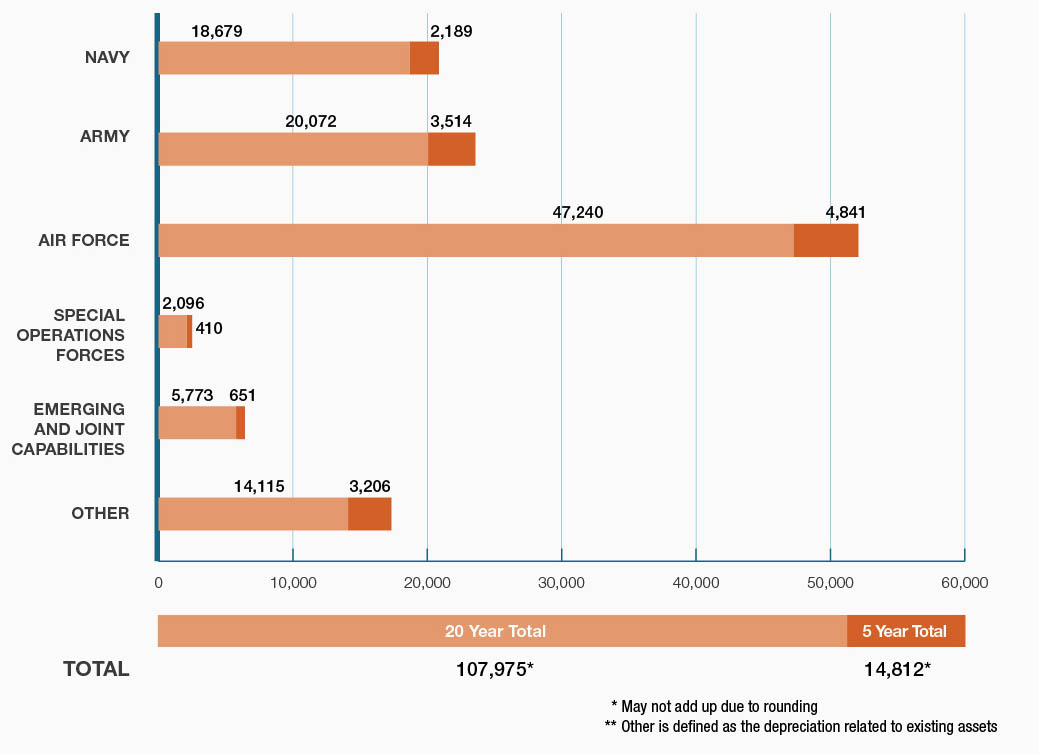
Table 3 - Text version
This bar graph shows capital spending on an accrual basis by domain in millions of dollars for the 20-year and 5-year periods in the Investment Plan. Six bars on the vertical axis show the spending for the Royal Canadian Navy (20-year: $18,679M; 5-year: $2,189M); Canadian Army (20-year: $20,072M; 5-year: $3,514M); Royal Canadian Air Force (20-year: $47,240M; 5-year: $4,841M); Special Operations Forces (20-year: $2,096M; 5-year: $410M); emerging and joint capabilities (20-year: $5,773M; 5-year: $651M); and other, which is defined as depreciation related to existing assets (20-year: $14,115M; 5-year: $3,206M). The horizontal axis shows the dollar thresholds ($10,000M; $20,000M; $30,000M; $40,000M; $50,000M; and $60,000M). The total bar below the horizontal axis shows the 20-year total ($107,975M) and 5-year total ($14,812M). Note: Totals may not add up due to rounding.
Table 4: Capital Expenses on an Accrual Basis by Asset Class ($millions)
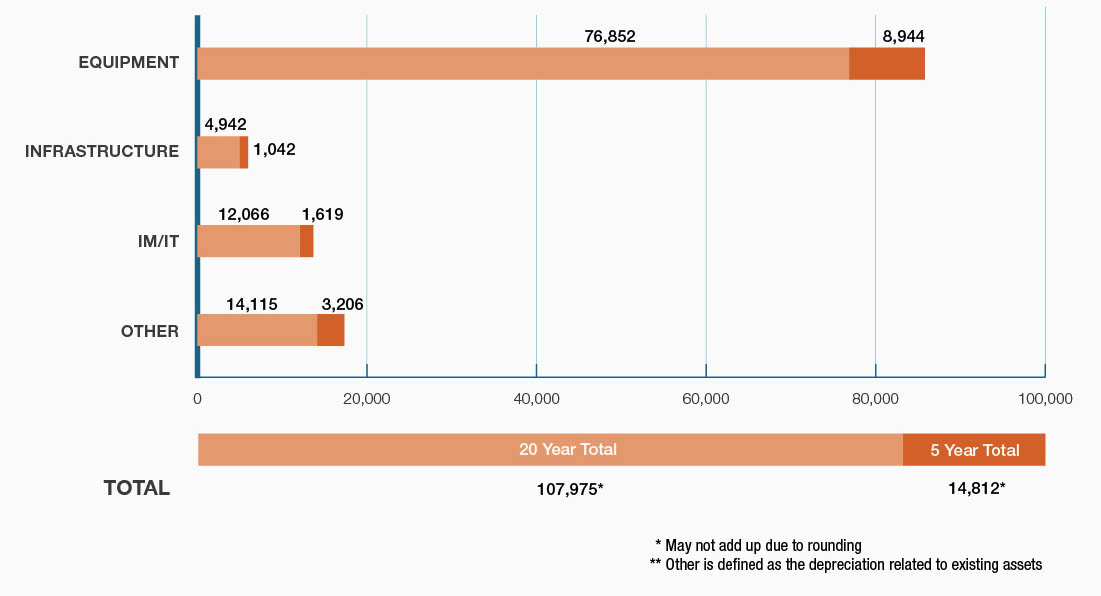
Table 4 - Text version
This bar graph shows capital spending on an accrual basis by asset class in millions of dollars for the 20-year and 5-year periods in the Investment Plan. Four bars on the vertical axis show the spending for the asset classes: equipment; infrastructure; IM/IT; and other, which is defined as depreciation related to existing assets. The horizontal axis shows the dollar thresholds ($20,000M; $40,000M; $60,000M; $80,000M; and $100,000M). The total bar below the horizontal axis shows the 20-year total ($107,975M) and 5-year total ($14,812M). Note: Totals may not add up due to rounding.
Table 5: Capital Investment on a Cash Basis by Domain and Asset Class ($millions)
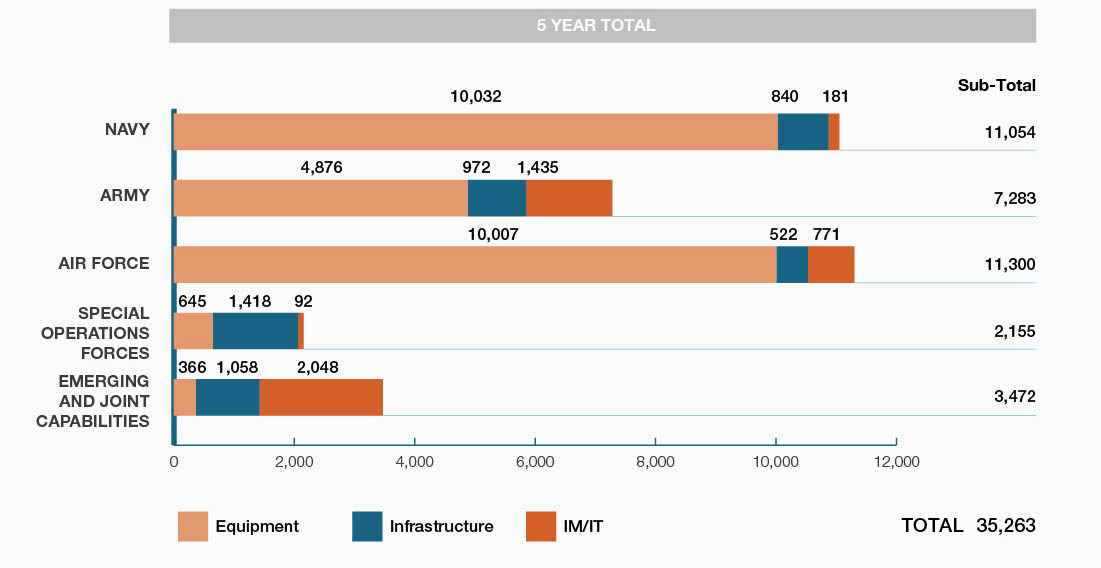
Table 5 - Text version
This bar graph shows capital spending on a cash basis by domain and asset class in millions of dollars for the 5-year periods of the Investment Plan. Four bars on the vertical axis show the spending for the domains; and each of these bars includes a breakdown for the asset classes. Royal Canadian Navy (equipment: $10,032M; infrastructure: $840M; IM/IT: $181M; sub-total: $11,054M); Canadian Army (equipment: $4,876M; infrastructure: $972M; IM/IT: $1,435M; sub-total $7,283M); Royal Canadian Air Force: (equipment: $10,007M; infrastructure: $522M; IM/IT: $771M; sub-total $11,300M); Special Operations Forces (equipment $645M; infrastructure $1,418M; IM/IT: $92M; sub-total: $2,155M); emerging and joint capabilities (equipment: $336M; infrastructure $1,058M; IM/IT: $2,048M; sub-total: $3,472M). The horizontal axis shows the dollar thresholds ($2,000M; $4,000M; $6,000M; $8,000M; $10,000M; and $12,000M). The grand total below the horizontal axis is $35,263M.
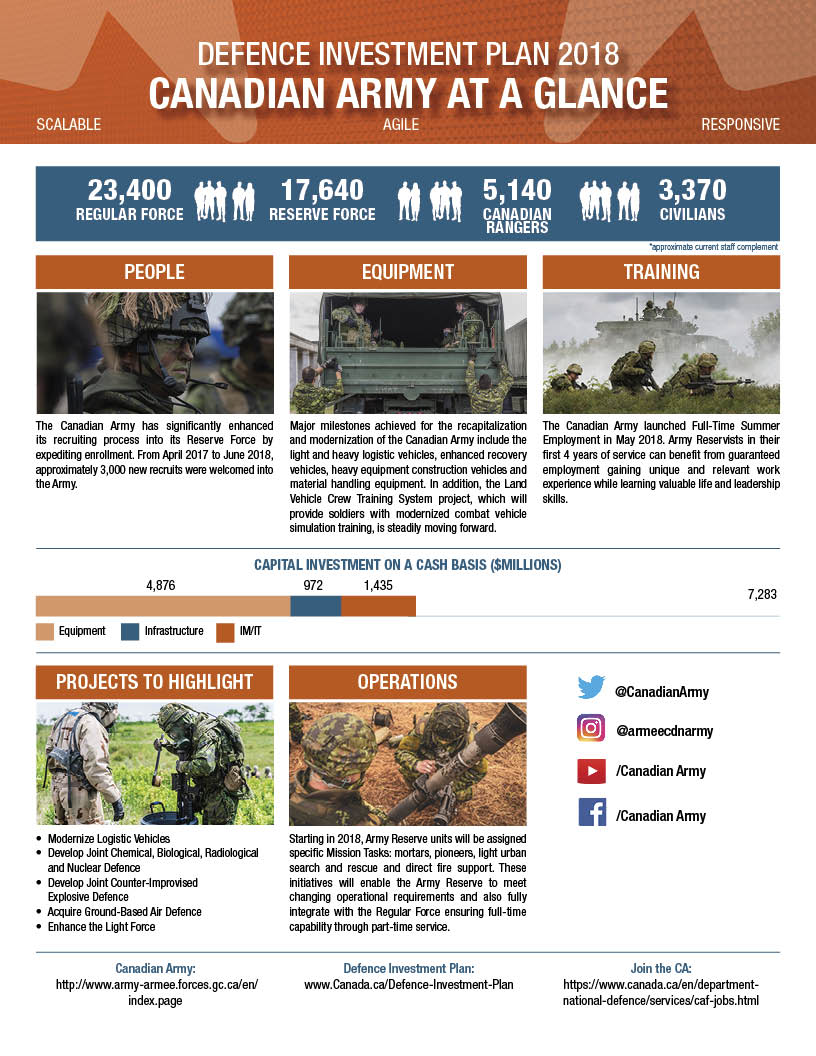
Text equivalent: Army at a Glance
Canadian Army at a Glance. This infographic provides descriptors, personnel statistics, and highlights examples of investments from the Defence Investment Plan 2018 with respect to the Canadian Army. The infographic is divided into six rows. The first row contains the header text. The second row contains personnel statistics. The third row contains three columns. The left-hand column presents a personnel story and related image, the middle column presents an equipment project and related image, and the right-hand column describes a training initiative and related image. The fourth row is a horizontal bar graph representing capital investments on a cash basis ($ millions). Read across from left to right for capital investments broken down by equipment, infrastructure, and IM/IT. The total value is presented on the right. The fifth row contains three columns. The left-hand column lists a selection of highlighted projects and a related image, the middle column presents an operations highlight and a related image, and the right-hand column lists the social media accounts for the Canadian Army. The sixth row contains hyperlinks to key online resources.
Header
Defence Investment Plan 2018
Canadian Army at a Glance
Scalable, Agile, Responsive
Personnel Statistics
Approximate current staff complement: 23,400 regular force; 17,640 reserve force; 5,140 Canadian rangers; 3,370 civilians
People
The Canadian Army has significantly enhanced its recruiting process into its Reserve Force by expediting enrollment. From April 2017 to June 2018, approximately 3,000 new recruits were welcomed into the Army.
Equipment
Major milestones achieved for the recapitalization and modernization of the Canadian Army include the light and heavy logistic vehicles, enhanced recovery vehicles, heavy equipment construction vehicles and material handling equipment. In addition, the Land Vehicle Crew Training System project, which will provide soldiers with modernized combat vehicle simulation training, is steadily moving forward.
Training
The Canadian Army launched Full-Time Summer Employment in May 2018. Army Reservists in their first 4 years of service can benefit from guaranteed employment gaining unique and relevant work experience while learning valuable life and leadership skills.
Capital Investment on a cash basis
Equipment – 4,876 $million
Infrastructure – 972 $million
IM/IT – 1,435 $million
Total – 7,283 $million
Projects to Highlight
- Modernize Logistic Vehicles
- Develop Joint Chemical, Biological, Radiological and Nuclear Defence
- Develop Joint Counter-Improvised Explosive Defence
- Acquire Ground-Based Air Defence
- Enhance the Light Force
Operations
Starting in 2018, Army Reserve units will be assigned specific Mission Tasks: mortars, pioneers, light urban search and rescue and direct fire support. These initiatives will enable the Army Reserve to meet changing operational requirements and also fully integrate with the Regular Force ensuring full-time capability through part-time service.
Social Media
Twitter: @CanadianArmy
Instragram: @armeecdnarmy
Youtube: /Canadian Army
Facebook: /Canadian Army
Links
Canadian Army: http://www.army-armee.forces.gc.ca/en/index.page
Defence Investment Plan: www.Canada.ca/Defence-Investment-Plan
Join the CA: https://www.canada.ca/en/department-nationaldefence/services/caf-jobs.html
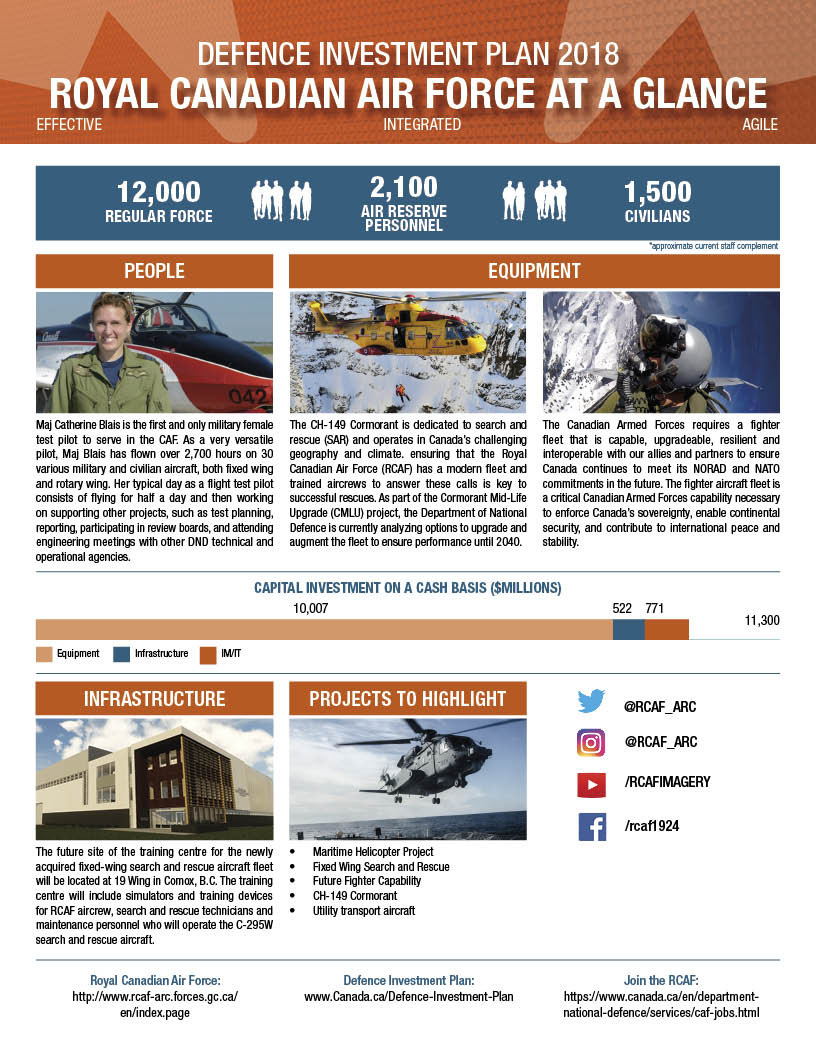
Text equivalent: RCAF at a Glance
Royal Canadian Air Force at a Glance. This infographic provides descriptors, personnel statistics, and highlights examples of investments from the Defence Investment Plan 2018 with respect to the Royal Canadian Air Force. The infographic is divided into six rows. The first row contains the header text. The second row contains personnel statistics. The third row contains three columns. The left-hand column presents a personnel story and related image, the middle column presents an equipment project and related image, and the right-hand column describes a second equipment project and related image. The fourth row is a horizontal bar graph representing capital investments on a cash basis ($ millions). Read across from left to right for capital investments broken down by equipment, infrastructure, and IM/IT. The total value is presented on the right. The fifth row contains three columns. The left-hand column presents an infrastructure project and a related image, the middle column lists a selection of highlighted projects and a related image, and the right-hand column lists the social media accounts for the Royal Canadian Air Force. The sixth row contains hyperlinks to key online resources.
Header
Defence Investment Plan 2018
Royal Canadian Air Force at a Glance
Effective, Integrated, Agile
Personnel Statistics
Approximate current staff complement: 12,000 regular force; 2,100 air reserve personnel; 1,500 civilians
People
Maj Catherine Blais is the first and only military female test pilot to serve in the CAF. As a very versatile pilot, Maj Blais has flown over 2,700 hours on 30 various military and civilian aircraft, both fixed wing and rotary wing. Her typical day as a flight test pilot consists of flying for half a day and then working on supporting other projects, such as test planning, reporting, participating in review boards, and attending engineering meetings with other DND technical and operational agencies.
Equipment
The CH-149 Cormorant is dedicated to search and rescue (SAR) and operates in Canada’s challenging geography and climate. ensuring that the Royal Canadian Air Force (RCAF) has a modern fleet and trained aircrews to answer these calls is key to successful rescues. As part of the Cormorant Mid-Life Upgrade (CMLU) project, the Department of National Defence is currently analyzing options to upgrade and augment the fleet to ensure performance until 2040.
Equipment
The Canadian Armed Forces requires a fighter fleet that is capable, upgradeable, resilient and interoperable with our allies and partners to ensure Canada continues to meet its NORAD and NATO commitments in the future. The fighter aircraft fleet is a critical Canadian Armed Forces capability necessary to enforce Canada’s sovereignty, enable continental security, and contribute to international peace and stability.
Capital Investment on a cash basis
Equipment – 10,007 $million
Infrastructure – 522 $million
IM/IT – 771 $million
Total – 11,300 $million
Infrastructure
The future site of the training centre for the newly acquired fixed-wing search and rescue aircraft fleet will be located at 19 Wing in Comox, B.C. The training centre will include simulators and training devices for RCAF aircrew, search and rescue technicians and maintenance personnel who will operate the C-295W search and rescue aircraft.
Projects to Highlight
- Maritime Helicopter Project
- Fixed Wing Search and Rescue
- Future Fighter Capability
- CH-149 Cormorant
- Utility transport aircraft
Social Media
Twitter: @RCAF_ARC
Instragram: @RCAF_ARC
Youtube: /RCAFIMAGERY
Facebook: /rcaf1924
Links
Royal Canadian Air Force: http://www.rcaf-arc.forces.gc.ca/en/index.page
Defence Investment Plan: www.Canada.ca/Defence-Investment-Plan
Join the RCAF: https://www.canada.ca/en/department-nationaldefence/services/caf-jobs.html
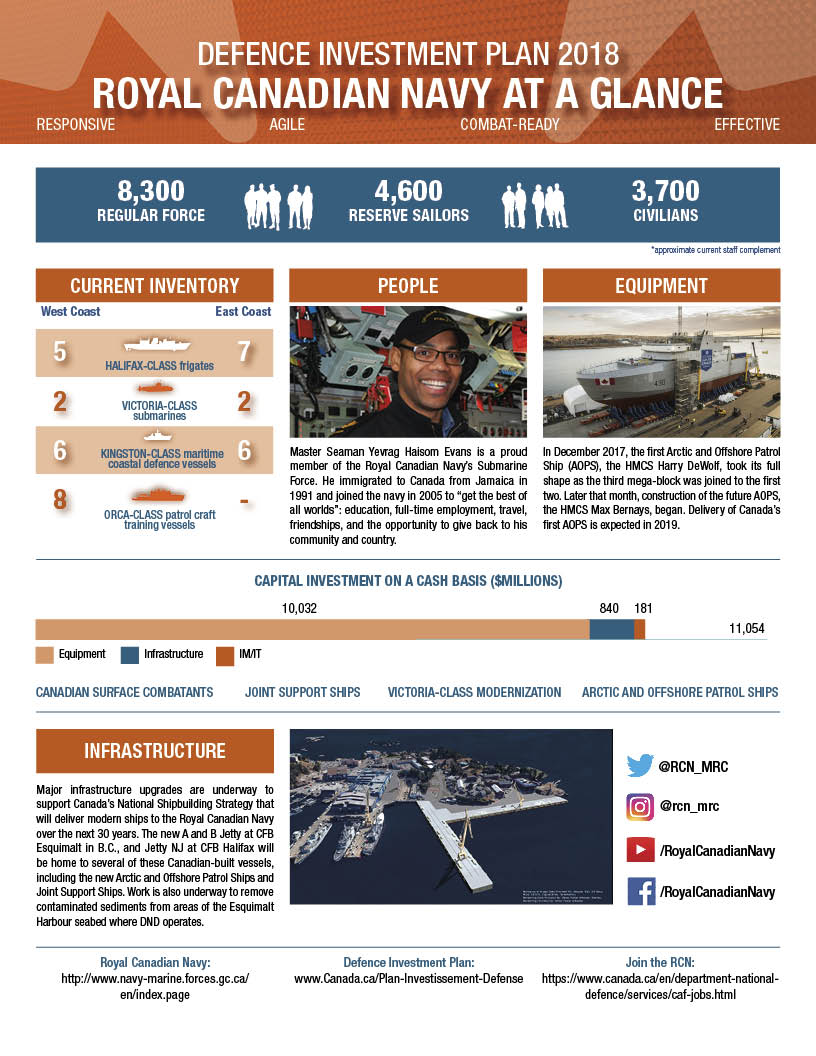
Text equivalent: RCN at a Glance
Royal Canadian Navy at a Glance. This infographic provides descriptors, personnel statistics, current inventory and highlights examples of investments from the Defence Investment Plan 2018 with respect to the Royal Canadian Navy. The infographic is divided into six rows. The first row contains the header text. The second row contains personnel statistics. The third row contains three columns. The left-hand column lists the current inventory, the middle column presents a personnel story and related image, and the right-hand column presents an equipment project and related image. The fourth row is a horizontal bar graph representing capital investments on a cash basis ($ millions). Read across from left to right for capital investments broken down by equipment, infrastructure, and IM/IT. The total value is presented on the right. A selection of projects is listed below the bar graph. The fifth row contains three columns. The left-hand column presents an infrastructure project, the middle column contains an image, and the right-hand column lists the social media accounts for the Royal Canadian Navy. The sixth row contains hyperlinks to key online resources.
Header
Defence Investment Plan 2018
Royal Canadian Navy at a Glance
Responsive, Agile, Combat-Ready, Effective
Personnel Statistics
Approximate current staff complement: 8,300 regular force; 4,600 reserve sailors; 3,700 civilians
Current Inventory
West Coast: five Halifax-class frigates, two Victoria-class submarines, six Kingston-class maritime coastal defence vessels, eight ORCA-class patrol craft training vessels
East Coast: seven Halifax-class frigates, two Victoria-class submarines, six Kingston-class maritime coastal defence vessels, zero ORCA-class patrol craft training vessels
People
Master Seaman Yevrag Haisom Evans is a proud member of the Royal Canadian Navy’s Submarine Force. He immigrated to Canada from Jamaica in 1991 and joined the navy in 2005 to “get the best of all worlds”: education, full-time employment, travel, friendships, and the opportunity to give back to his community and country.
Equipment
In December 2017, the first Arctic and Offshore Patrol Ship (AOPS), the HMCS Harry DeWolf, took its full shape as the third mega-block was joined to the first two. Later that month, construction of the future AOPS, the HMCS Max Bernays, began. Delivery of Canada’s first AOPS is expected in 2019.
Capital Investment on a cash basis
Equipment – 10,032 $million
Infrastructure – 840 $million
IM/IT – 181 $million
Total – 11,054 $million
Highlighted Projects: CANADIAN SURFACE COMBATANTS, JOINT SUPPORT SHIPS, VICTORIA-CLASS MODERNIZATION, ARCTIC AND OFFSHORE PATROL SHIPS
Infrastructure
Major infrastructure upgrades are underway to support Canada’s National Shipbuilding Strategy that will deliver modern ships to the Royal Canadian Navy over the next 30 years. The new A and B Jetty at CFB Esquimalt in B.C., and Jetty NJ at CFB Halifax will be home to several of these Canadian-built vessels, including the new Arctic and Offshore Patrol Ships and
Joint Support Ships. Work is also underway to remove contaminated sediments from areas of the Esquimalt Harbour seabed where DND operates.
Social Media
Twitter: @RCN_MRC
Instragram: @rcn_mrc
Youtube: /RoyalCanadianNavy
Facebook: /RoyalCanadianNavy
Links
Royal Canadian Navy: http://www.navy-marine.forces.gc.ca/en/index.page
Defence Investment Plan: www.Canada.ca/Plan-Investissement-Defense
Join the RCN: https://www.canada.ca/en/department-nationaldefence/services/caf-jobs.html
Table of contents
Page details
- Date modified: